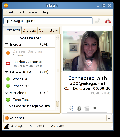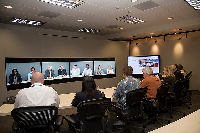Different forms of Video Communication
This post was translated in Armenian.
A video is a series of images captured at a rate faster than the eye can perceive. Each image is comprised of many pixels. More pixels indicate more clarity, this is known as resolution. As you can imagine, a video file in the raw (original) format would be huge. Thanks to the digital technologies and availability of advanced digital encoding (i.e. compression) techniques, it became possible to compress these large video files into much smaller files that could be transmitted without much loss or delay. This, along with the availability of high speed IP networks facilitated video as a new means of communication.
Some of the common forms of video communication are Video Calling, Video Conferencing, Telepresence and Video Sharing.
Video Calling
|
http://commons.wikimedia.org/wiki/File:IP_Video_Phone_1535-DSCN1202-2.JPG Creative Commons Attribution-Share Alike 3.0 Unported |
|
|
Creative Commons Attribution-Share Alike 3.0 Unported |
Figure 1: Different forms of video calling – on landline, mobile and internet (e.g., on Facebook)
Video Calling is a service where two people can communicate using video, i.e., can see as well as hear each other on the phone or a personal computer (PC).
On the landline network: Video calling from PC to PC over internet is usually available as a free service, for example, from providers like Skype, Yahoo Messenger, and more recently Facebook. The user has to be logged into the application to receive the call. The availability of the user, also known as presence, is indicated to other people with a status like offline, available, etc. These services are charged when the communication has to cross over from the internet to a telecom network, and has to pass through an interconnect gateway. This situation arises when you try to call a mobile or landline number from a PC video calling application. The telecom operators charge for interconnection to their network, and so the users are charged for these calls. Detailed working will be discussed in module 2.8.3.
On the mobile network: Video Calling used to be a facility limited to PCs or Internet Protocol (IP) phones using an internet connection, until the availability of Third Generation (3G)[1] technologies on the mobile. With 3G, came the concept of a special call type for video, using a new protocol[2] known as H324M. It uses the Circuit Switched Mode of operation, where a 64 kilobits/sec (Kbps) channel in each direction is reserved for the call for the entire duration of the call. 3G capable handsets support this and provide a menu option to make a video call to any number in the phone book. However, 64kbps is usually not enough for high quality video. The better mode of operation is the Packet Switched Mode,[3] where there is no hard limit on the bandwidth available for the call.
Video calling on the internet, as well as on the mobile in the Packet Switched mode uses protocols like H323 or Session Initiation Protocol (SIP).[4] The Circuit Switched and Packet Switched modes will be discussed in more detail in module 2.2.2. Since data (internet) connections with decent speed and low enough latency[5] are also available on mobile now, the internet video calling applications like Skype once available on the landline network also work seamlessly on the mobile.
One limitation that prevents the use of video calling on the mobile is that many handsets do not have a front camera, and hence one cannot see the other person and be seen at the same time.
Video Conferencing
|
|
Figure 2: Video Conferencing on multiple devices
A video call that involves more than two people where all the parties can hear each other and a specific number of people can be seen by the others is called a video conference. The video screen appears as a grid with a number of screens that can be viewed simultaneously. The voice of the speaker is detected to show the video of the current speaker.
The way video conferencing works is that one video stream[6] is transmitted by each participant to a Multipoint Conferencing Unit (MCU). The MCU decides which of the streams to combine to form a single video stream to send to all the participants. For the audio portion, the MCU combines the audio streams from all the participants and transmits them to the recipients as a single stream.
Another simpler form of video conferencing available is a decentralized mode, where every person can see every other person, without any central control. This is in effect like multiple video calls from each person to every other person. This offers higher quality, but utilizes higher bandwidth because it requires a separate stream from each individual to every other person in the call. Skype offers a service called group calling which uses this philosophy.
Nowadays, with the use of High Definition (HD) cameras and videoconference solutions as a cloud offering, high quality video conferencing can be used with no fixed hardware investment. The meaning of “Cloud offering “is that all the hardware/ software is placed at a central location and not at the user premises. The only hardware needed at the user premises is a camera and a terminal (computer).
Telepresence
|
|
Figure 3: Telepresence – a sophisticated video conference
Telepresence is a sophisticated form of a video conference, where a real life setting is simulated, so that it appears as if the other party is sitting in the same room. This requires specially designed rooms with cameras, TV screens and special seating arrangements. For example, one setting uses a curved or U-shaped seating; so that it appears that the other room is actually a different section of the same room. Also, the sound is transmitted as High Definition (HD), which makes it sound real. There are multiple screens, and each screen can display people from a room, or a projected document which can be viewed by all the rooms.
Telepresence solutions are provided by companies like Cisco, Polycom and so on, and usually used for corporate meetings across different geographical locations. These solutions are typically very expensive. For corporations or individuals cannot afford the upfront investment of a dedicated room, equipment and bandwidth required for telepresence, public telepresence rooms are offered on a rental basis in the important cities. (e.g. the Tata Public telepresence service).
Video Sharing
|
http://en.wikipedia.org/wiki/File:Teliris_VL_Unified_2.jpg |
Figure 4: Video Sharing
Video Sharing is an application where a person shares what he is viewing with another person in real time during a voice call. It uses a packet data connection parallel to the connection used for the voice call. When the video is shared, the recipient’s phone switches on automatically, and they can also in parallel continue the conversation. Some people also refer to an application that allows a user to upload his videos to a central location and make it available for viewing by others, for e.g. YouTube., as Video Sharing.








